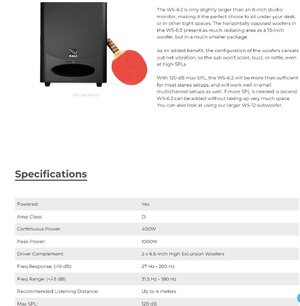Matching subwoofers, both are 150w and with the same input produce 86db individually, play them both together and the only thing that has changed is the doubling of the surface area, hence the 3db increase.
You have a 7 channel Receiver that that puts out 50w per channel, which means a total of 350w, however the sound produced by the speakers is still only 50w each as they are individual with their own dedicated channel . (Just because you have more power doesn't mean more volume unless you increase the power on the channel)
If you connect to drivers to 1 amp then you should also get 3db (In reality it is less due to the way the drivers interact to each other), now if you double the output of the amp as well then you will get a theoretical 6db increase in output (Due to losses and interaction it will always be less)
To put it simply, adding an extra separate amp to drive another speaker, does not give you double the power output. (That's not how amplification works)
Bill
Your analogy doesn't work at all. Subwoofer signals are almost always mono in nature, even in stereo sub situations, as low bass is almost always mixed down to mono, whereas in an AVR, you have wildly different signals going to each individual bed channel. But even then, quarter wave and constructive interactions occur, which is why the center channel signal is rerouted into FL/FR at an individually lower output so the center channel information doesn't overwhelm the front stage.
Let's take a single driver subwoofer with a 1000W amplifier. Let's say it has a max output of 100dB.
Scenario A) If we simply double the amplifier power to 2000W, we are now increasing the amplitude by 3dB for 103dB. Same concept as needing double the power for a loudspeaker with 85dB sensitivity to produce the same SPL as an otherwise identical speaker with 88dB sensitivity.
Scenario B) If instead we redesign the subwoofer to hold two drivers with equal performance, but use the same amplifier, each driver can produce 100dB for the same system wattage (1000W total), even though the wattage to each driver has been halved (500W each). The two drivers have acoustically coupled at frequencies with a wavelength greater than 4x the distance between the drivers, which is the quarter wave theory. This is gives us 100dB+100dB, for 103dB.
Scenario C) But let's spend a bit more money and buy two 1000W amplifiers to sit in our subwoofer instead, one serving each driver, receiving the same signal - along the lines of a PV1D or a KC92. We have double the system power AND double the cone area. We know that our individual drivers will output 100dB each when powered by 500W, so at 1000W, they would now each be producing 103dB. When the sound waves hit each other, through acoustic coupling the amplitudes add together, for 103dB+103dB=106dB. So +6dB from our now dual driver, dual amplifier subwoofer.
Now just put one of each amplifier and driver combo in their own boxes instead - two separate subwoofers. Signal path hasn't changed whatsoever, but we have doubled both cone area and system wattage. Both amplifiers and both drivers are still receiving what they receive when they are in one box, as per scenario C. The sound waves don't care. All they care about is that the sources are within a quarter wavelength of a given frequency, acoustically coupling, giving us +6dB for doubling cone area and doubling amplification.
This has been well understood by audio engineers and loudspeaker designers for a long, long time.




